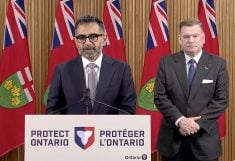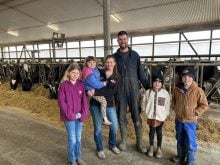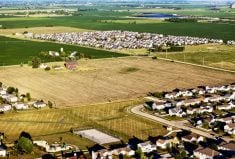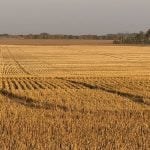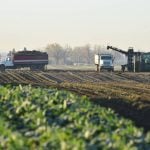Farm groups say they want federal political parties to prioritize agricultural issues in the federal election.
Their main requests include Business Risk Management (BRM) programs, like AgriStability, climate change, environmental concerns and trade and market access.
Why it matters: The pandemic provided a focus on agriculture’s critical role in feeding the nation and in post-pandemic economic recovery. Now agriculture organizations want the federal parties to make agriculture a priority in their platforms.
Read Also

Packer buys Green Giant, Le Sieur veg brands from U.S. owner
A Quebec-based processor’s deal to buy the Green Giant and Le Sieur packaged and frozen vegetable brands in Canada from a U.S. owner clarifies the status of two popular retail brands grown by Canadian farmers.
The government and financial institutions have repeatedly identified Canadian agriculture as a sector that can achieve incredible growth, said Mary Robinson, president of the Canadian Federation of Agriculture (CFA).
“Yet consecutive governments have failed to provide any kind of increase in consistent funding to actually achieve this growth,” she said. “Failing to even keep up with inflation. Farming and food production is truly an essential industry, and we need to see actions that support and propel the industry to new heights.”
The CFA has zeroed in on increased funding for the next policy framework, which will influence the bulk of agriculture funding in 2023.
AgriStability is like car insurance, said Keith Currie, CFA’s first vice president and Ontario farmer. You budget for it, pay into it and hope you never have to use it, but if you do, it’s triggered automatically, and you know you’re covered.
Unlike AgriStability, car insurance provides a suite of coverage options, trigger points and a template to immediate disperse assistance to the client, regardless of the claim.
“It’s very complex and it’s easier to say than to do,” acknowledged Currie. “But to try and create a one-size-fits-all is very difficult.”
Farmers in Holland Marsh, who have small acres but high value crops, don’t fit into the same bracket as a grain farmer or hog producer, he said.
The CFA wants some assurance that the AgriStability program will be available and adequate until it transitions into something better in the future.
There also needs to be a defined line between programing that deals with climate change and those that deal with environmental issues and investment upfront for adaptation, mitigation, and environmental prevention. Which, Currie pointed out, is cheaper than recovery spending.
“It costs a lot less to prevent than it does to fix,” Currie said. “It’s like me in the shop all winter going over my tractors and equipment, so they don’t have those costly breakdowns in the spring or the summer.”
The five-province drought is the perfect example of where the AgriRecovery could be improved with existing disaster templates, programming-in-place and adequate funds would expedite support instead of scrambling for ad-hoc funds and program creation.
Currently, each individual province will have to submit a recovery ask and wait for payment.
Outside of the collective requests, the Ontario Federation of Agriculture (OFA) is concerned about ongoing labour challenges, said Peggy Brekveld, OFA president.
Before the pandemic, the Canadian Agricultural Human Resource Council (CAHRC) noted in 2017, 16,500 agriculture jobs went unfulfilled, resulting in $2.9 billion in lost revenues. The CAHRC projects that shortfall will reach 123,000 nationally by 2029.
“Half of that (shortfall) is in Ontario because we have a lot of greenhouses, fresh produce industries and a significant processing sector,” said Brekveld. “We certainly need to address labour in this province as far as agriculture goes.”
Agriculture can drive economic growth in Canada even further, but that growth hinges on developing a healthy labour force.
Brekveld said that Ontario and Canada need a healthy labour strategy that includes ag-related education program development, effective immigration policies for temporary foreign and seasonal workers, and investment into the research and adaptation of labour-saving innovation and automation within the sector.
“Nationally, we’re looking at the next policy framework to include solutions for labour, automation, innovation and a labour strategy.”
While some Ontario colleges offer programs that address agriculture labour shortages, such as Conestoga College’s 16-week Agricultural Equipment Operator certificate program, more promotion on the breadth of agriculture opportunities needs to occur at the high school and trade show level.
“Practically every field inside of a university setting or a college setting can have applications in agriculture,” Brekveld said, pointing to accounting, high tech robotics, cellular development or environmental conservation. It all applies.
GFO looks for program details
Before the writ dropped, the federal government announced a retroactive rebate for direct carbon pricing applied to grain drying. Still, it lacked details, said Brendan Byrne, Grain Farmers of Ontario (GFO) chair.
“There’s a lot of money that’s been paid out for a carbon tax piece on grain drying by our farmer members,” said Byrne.
He would like to see numbers reflecting payments made into the carbon tax for grain drying and what a retroactive rebate on those funds looks like for GFO members.
On its current trajectory, the carbon tax will reach $170 a tonne by 2030 with a total of $2 billion to upwards of $4 billion on a worst-case scenario, collected from Ontario grain farmers.
GFO would like to partner with the government to craft a low-carbon toolbox to achieve Canada’s net-zero objectives within the grain sector. Currently, there isn’t a viable alternative fuel for grain drying that is compliant.
Politicians who lack the boots-on-the-ground understanding may not realize that grain dryers run sporadically to dry down the grain to be stored before it continues into the food chain or ethanol production.
“Some of those pieces get lost when it’s just government on their own putting it together,” he said. “We want to be at the table to, at the very least, provide clarity to what is being proposed. If there is something that we can say to have them look at it from a farm perspective, we’re able to do that.”
During COVID-19, farmers kept their heads down and continued to do their best to provide high-quality, safe and affordable food to Canadians, said Byrne.
Now they need to spark conversations with candidates and leaders on how agriculture can be a part of the country’s economic recovery, especially if the incoming government can hash out tariff disparities and workable solutions to sector issues.
“I mean there’s no harm in having a back and forth about different sides of an issue, but at the end of the day, it’s how is this going to affect Canadian farmers, the person around the table that is eating Canadian grains or any of these other sectors?” Byrne said. “You look at it from the lens of your particular sector, but at the same time, I think we all just want what’s best for our country.”




